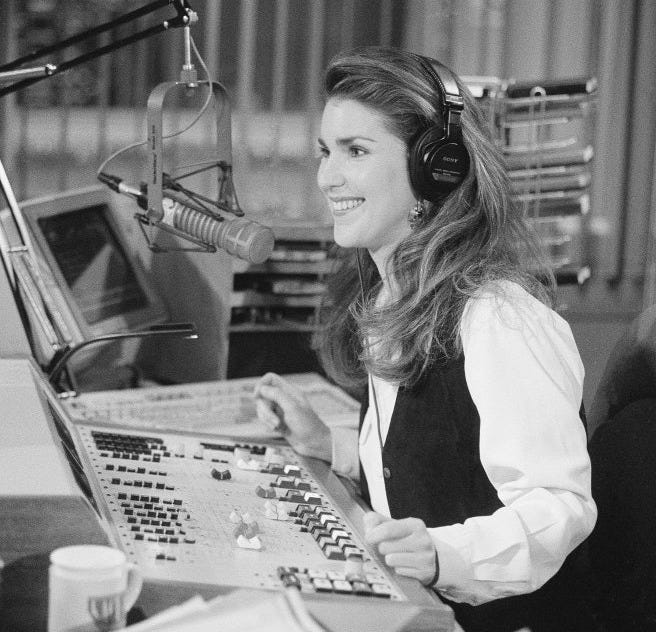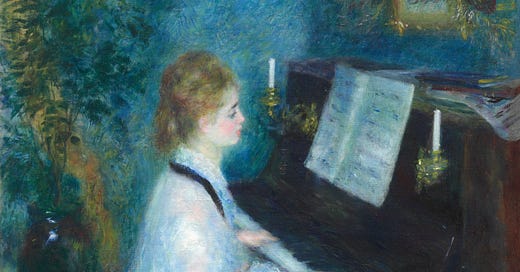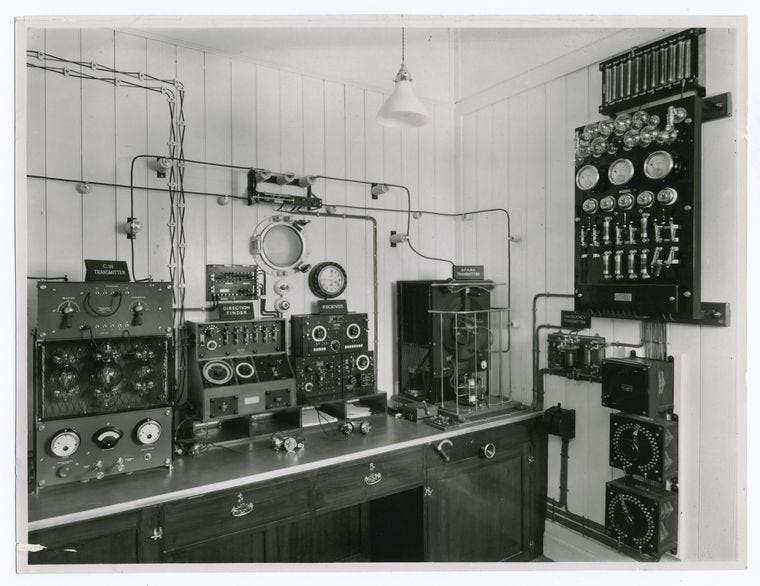Thank You for the Music
the history of radio, broadcasting classical music, and Frasier (feat. a lot more of the Titanic than you'd expect)
In case you missed it, I started volunteering at my local classical radio station.1 I wrote about it already here, but the long-story-short is that I emailed the classical station in November about auditioning to be an announcer after hearing a call for volunteers on the radio. I passed my audition, went to a 6 week class, sat through a few shifts with mentors, had a shift where I broadcast with a staff announcer watching me, and after many months, was on the schedule, key-card in hand, going solo.
Out of our announcing class of about 20 people, two people left the volunteer class to be hired to work overnights (I said, “No thank you; I like having a sleep schedule.”), and three people (including myself) became volunteer announcers. The rest of the class perished (metaphorically speaking). So when our class instructor Mike said: “Look to your right and look to your left. One of you won't make it,” in class, he wasn’t wrong.
I've met nearly all of the announcers at this point, and I'm the youngest one in the crew thus far. The vast majority of staff and volunteers are middle aged or older. Shocker: there's not a lot of young people in the classical radio business.
I have not received any marriage proposals via radio station phone or mail yet,2 though I did settle on my fake name. Unfortunately, one of the shows shares my last name, so I sound a little silly introducing myself on air during that specific show, but c'est la vie. (Think “Music of the Night” with “Jessi Night.”) It didn’t sink in that I could actually be heard over the airwaves until I started to introduce myself to a station engineer whom I hadn’t met yet, and he stopped me, saying, “I know who you are. I heard you on the radio.”
Since I’m now a bona fide radio star, I’ve taken it upon myself to learn a little more about the history and culture of radio. I've started watching Frasier because Ruth, an announcer who introduced herself to me as a “Jewish vegan activist,” told me that I needed to watch it, so I could understand the references. Ruth’s true passion, though, (beyond being Jewish, vegan, and an activist) is opera, which she was embarrassed to tell me. “You probably think I'm so lame,” she lamented. “Ruth,” I said, “I'm a 22 year old volunteering at the classical radio station.” “Fair point,” she said.

I’ve watched a good amount of Frasier now. (Would recommend, but I don’t believe the show would air today.) In my head, I’m Roz: funny, on top of it, effortlessly good at my job. In reality, I think I’m more of a Frasier: a little frazzled, a little pretentious, and a little disappointed in the general public of the greater Triangle area. (Yes, I am referring to the guy who calls and asks about your shoe size when you’re on the air.)

I attribute some of my love for radio to growing up with it, and living, all things considered, a rather analog childhood despite being a 2000s baby. The classical station was always playing from someone’s clock/radio/cd player combo in my house, and we had a trusty set of walkie-talkies that we used to communicate with some neighbor kids who lived on the other side of the neighborhood. (The walkie-talkies only had a 1-mile range, but if our neighbors biked up a street from their house, we could just barely make the connection.)
Of course, I refer to radio as an analog technology, but at one point, it was the shiny new invention.
A lot of science went into developing radio. That’s not my strong suit, so I’m going to skip over all that. Know that the science (and James Clerk Maxwell) was great and impressive.3 What matters for us today is that the first long-distance broadcast was in 1899, when Guglielmo Marconi telegraphed the results of a yacht race while on a ship at sea to New York. He won a Nobel prize for his scientific efforts and earned the title “Father of Radio.”
For a while, radio was restricted to morse code messages. While it's not confirmed, the first song broadcast over the airwaves is believed to be “O Holy Night,” which was heard on Christmas Eve, 1906. Reginald Fessenden reportedly broadcast himself talking and playing violin from his station at Brant Rock, Massachusetts, and his signal was picked up as far as Norfolk, Virginia. (He was unable to develop the technology further, and left the field of radio to explore something new. According to the DPLA, “Spurred by the sinking of the Titanic, he moved on to a more lucrative business in inventing iceberg-detecting technology.”)
Scientists figured out how to amplify radio waves shortly later, and the public started to get into radio in the 1910s. Some people paid operators to use radio to communicate, and some people got into amateur radio. At this point, communications still utilized morse code. Before 1912, amateur radio broadcasters were largely unregulated. What happened in 1912, you ask? The unsinkable Titanic hit an iceberg and sank.
The Titanic was outfitted with a Marconi machine (named for Guglielmo Marconi, the Father of Radio). Most passenger ships in the North Atlantic had a Marconi machine in them, staffed by the Marconi Company. Marconi himself would often sail with the ships. Ships could communicate with other ships or back to shore, using morse code (remember, voice broadcast hadn’t adequately developed yet). This technology was still something of a novelty—and wealthy passengers who were willing to shell out had the privilege of sending messages back to shore.
A note about broadcasting: broadcasting a message over the airwaves wasn’t like sending a message down a direct line to the destination. Broadcasting on radio was a bit like shouting into a room in a house. Anyone who is in the room you’re shouting into can hear you. If other people are also shouting at the same time into the same room, well, it might be hard for your message to get heard.
On the night the Titanic sank, a lot of people were yelling in the same room. Jammed with passenger communications, messages from other ships warning the Titanic of icebergs were unreceived or ignored.
Additionally, there was only one operator for the radio on each ship, and they had to sleep at some point. When the Titanic struck the iceberg, the Titanic’s radio operator sent out distress calls (one of the first times SOS was utilized), but many nearby ships’ radio operators were asleep. The radio operator on the ship Carpathia was still awake and received the distress call from the Titanic. He turned the Carpathia towards the Titanic (still 60 miles, ~4 hours, away). The Carpathia arrived 2 hours after the Titanic sank, but it was able to retrieve all of the survivors in the lifeboats. If not for radio, everyone on the ship would have died.
Still, it was clear that radio, though it had helped the survivors of the Titanic, had serious issues. Enter the International Radiotelegraph Conference and the Radio Act of 1912. The Radio Act of 1912 added safeguards (like more trained radio operators on ships), as well as cracked down on amateur radio, so the airwaves wouldn’t be so jammed up by unregulated broadcasters. According to the National Institute of Standards and Technology, the Act “required licensing of commercial and amateur radio stations, minimizing interference communication between stations, addressing types of wavelengths used and prohibiting interference in radio communication.”
Science soon developed after this for voice to be broadcast over air across farther distances and more clearly. People started buying radios for their homes. The Golden Age of Radio, from 1920 to 1950, is when radio took off and boomed. Entertainment shows, news broadcasts, and music could all be heard on the all-in-one entertainment device. The popularization of television in the 50s ushered in the end of the golden age, but radio continued to have a place in people’s lives.
Radio became more music-focused in the 50s and following (which makes sense, considering that television took over many of the radio shows. “I Love Lucy,” the television show, sprang forth from the 1948 radio program, “My Favorite Husband.”) Sporting events were also broadcasted over the radio, even after television entered the scene. When America was segregated, radio was a way for black and other minority communities to be involved in community events and stay up to date, and radio was cheaper than a television set. The boxing fight between Joe Louis, black heavyweight champion, and white German opponent Max Schmeling, in 1938, had one of the largest radio audiences in history—an estimated 70 million people listened to it on their radios, according to NPR. (Louis won—a real as well as a symbolic victory against the Aryan rhetoric being pushed by the Germans.)
Radio (especially independent stations) was a way for people to connect over niche interests. For example, “The National Farm and Home Hour” which ran from 1928-1958, was produced with the US Department of Agriculture, and was aimed at rural farmers. Like the NBC ad says, “programs must have a basic reason for existence, must offer a real service either in entertainment or in education.” Radio stations specifically for jazz, classical music, opera, rock, and more formed during this time.
It’s a technology that centers around connecting with people—to relay messages from far away (about yacht races or family births or icebergs), to entertain (radio shows, sports, and music), to stir up (political talk shows, speeches), to educate (NPR), or to inspire (religious programming). Radio might soon go the way of the dinosaurs (and the way of Walkmans, VHS tapes, and film cameras), but it’s a joy to participate in a medium that has a rich history of bringing people together across vast distances over shared interests.
When Reginald Fessenden played violin and spoke across the airwaves for the first time in 1906, his ultimate goal was monetizing radio (people never change). But I think it is beautiful that the first human thing broadcast over the airwaves was music.
One of the staff announcers at the classical station told me that she never says “Thank you for listening” to listeners. She used to, but she stopped after she interviewed a famous flutist who told her that musicians provide a service to listeners. Thanking someone for listening makes the listeners think that they are providing a service just by being there, when it should be the other way around, with the audience saying to the musician, “thank you for the music.”
Truthfully, I thought the musician sounded a bit stuck-up and pretentious. I understand that the station is listener-supported (and we want them to be thankful with their pocketbooks when drive time rolls around), but it’s a give and take. The classical radio station provides a service by broadcasting ad-free great classical music, and yet the station wouldn’t exist without classical music fans who tune in and listen, even when Spotify is available. It’s a lovely community of people, centered around the niche of classical music, and I hope it will continue on for a long while.
To close, I think the words of the great philosophers of the 70s, ABBA, fit well here:
“So I say thank you for the music, the songs I'm singing
Thanks for all the joy they're bringing
Who can live without it? I ask in all honesty
What would life be?
Without a song or a dance, what are we?
So I say thank you for the music, for giving it to me.”
If you made it to the end of this rather wordy info-dump of radio history and personal anecdotes, thanks for reading. I hope you’ll listen to your local independent radio station. You can also enjoy some of the songs I’ve played on the radio, compiled on Spotify. (Because despite my love of radio, I still have a Spotify account. The duality of man.)
Bibliography:
Estep, George (May 11, 1986). "A Beautiful Day in the History of Chicago Radio." Chicago Tribune, https://web.archive.org/web/20191106015524/https://www.chicagotribune.com/news/ct-xpm-1986-05-11-8602020825-story.html
Boss, Alex. “NIST and the Titanic: How the Sinking of the Ship Improved Wireless Communications for Navigating the Sea.” NIST, April 13, 2022, https://www.nist.gov/blogs/taking-measure/nist-and-titanic-how-sinking-ship-improved-wireless-communications-navigating.
Brady, Hillary. “The Golden Age of Radio in the US.” Digital Public Library of America, May 2014. https://dp.la/exhibitions/radio-golden-age.
“The Development of Radio,” PBS, https://www.pbs.org/wgbh/americanexperience/features/rescue-development-radio/.
“Titanic, Marconi and the wireless telegraph,” Science Museum, 24 October 2018, https://www.sciencemuseum.org.uk/objects-and-stories/titanic-marconi-and-wireless-telegraph.
The Miriam and Ira D. Wallach Division of Art, Prints and Photographs: Photography Collection, The New York Public Library. "A modern Marconi ship's 1? KW installation including a continuous wave valve transmitter; wireless direction finder; 4 electrode valve amplifier and tuner; quenched spark transmitter; emergency spark transmitter." New York Public Library Digital Collections. https://digitalcollections.nypl.org/items/ceea3a00-c612-012f-8811-58d385a7bc34
“What Was The First Song Ever Played On The Radio?” Atlas Records, January 4, 2024, https://atlasrecords.co.uk/blogs/all-about-vinyl/what-was-the-first-song-ever-played-on-the-radio?srsltid=AfmBOopjzxfFF2YRApk27_oDplXpjLsa6Xa0oIfHdDeq-iedG4jIMHDR.
I apologize to my IRL friends who can’t have possibly missed it; radio has become my personality.
One of the reasons the women in the class were advised to create a fake name for their radio “persona” was because the Classical Station has a wide-ranging array of listeners. One of the staff announcers kept a stack of marriage proposals she received from men (some of whom were writing from prison) on her desk. I guess they thought she had a nice voice.
In my high school Charlotte Mason Physics class (I’m as homeschooled as they come), we had to read a biography about James Clerk Maxwell. I did not appreciate him as much then as I should have. He was also a devout Christian, so another win for Christianity and science.







This was a joy to read!! ☺️